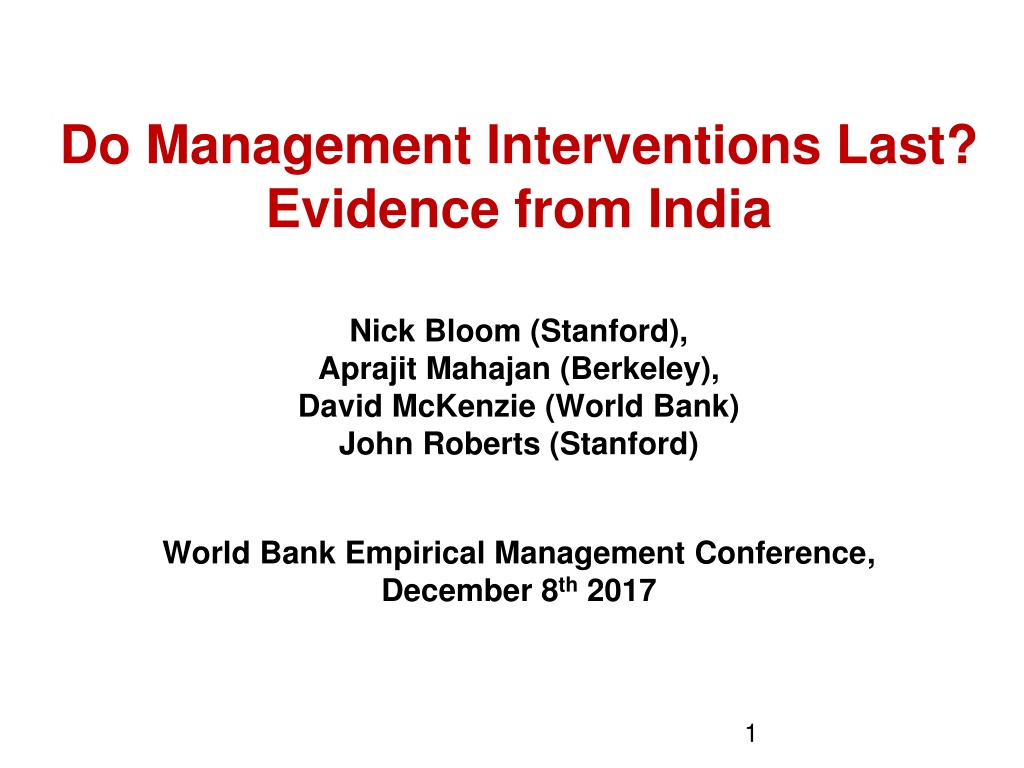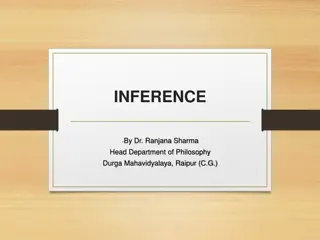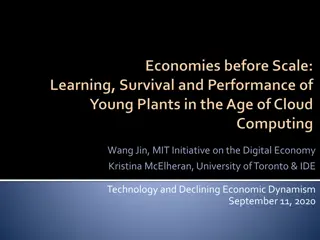Management Interventions' Long-Term Impact in Indian Firms
This study examines the lasting effects of management interventions in Indian textile firms over an 8-year period, revealing that while some improvements were reversed, treatment remained significant for management and performance. Factors like managerial turnover influenced the persistence of these impacts. The research project conducted an India management RCT from 2008-2010, providing free management consulting to 17 large textile firms. The intervention targeted 38 core textile management practices in 6 areas, showing that practices spread within plants, though not between firms. The findings highlight the importance of senior employees in sustaining effective management practices.
Download Presentation

Please find below an Image/Link to download the presentation.
The content on the website is provided AS IS for your information and personal use only. It may not be sold, licensed, or shared on other websites without obtaining consent from the author.If you encounter any issues during the download, it is possible that the publisher has removed the file from their server.
You are allowed to download the files provided on this website for personal or commercial use, subject to the condition that they are used lawfully. All files are the property of their respective owners.
The content on the website is provided AS IS for your information and personal use only. It may not be sold, licensed, or shared on other websites without obtaining consent from the author.
E N D
Presentation Transcript
Do Management Interventions Last? Evidence from India Nick Bloom (Stanford), Aprajit Mahajan (Berkeley), David McKenzie (World Bank) John Roberts (Stanford) World Bank Empirical Management Conference, December 8th 2017 1
Motivation Surge in management interest in economics (Roberts 2017), reviving old interest (e.g. Walker 1887, Marshall 1887) Recent work has started to establish a causal link between management interventions and performance in large firms e.g. Bloom et al. (2013), Bruhn et al. (2016) Question is how persistent are these impacts limited evidence (e.g. Gioricelli 2017)
This paper runs an 8-year follow up to the India firms experiment in Bloom et al. (2013), finding 1. While 50% management practice improvement reversed, treatment still significant for management and performance 2. Many management practices appear to have fully spread between plants within (but not between) firms 3. Managerial turnover and Director time two major reasons for drop in practices, suggesting senior employees matter
Background Current Research Project Results
2008-2010 ran an India management RCT (Bloom, Eifert, Mahajan, McKenzie & Roberts, 2013) Worked with Accenture to provide free management consulting to 17 large ( 250 employee) Indian textile firms running 28 plants From these firms 20 experimental plants were randomized into 14 treatment plants (1 month diagnostic, 4 months consulting) 6 control plants (1 month diagnostic). Then collected 1 year of performance data 5
Intervention aimed at 38 core textile management practices in 6 areas
Intervention aimed at 38 core textile management practices in 6 areas
Typical organization of one of the textile firms Directors own all equity and occupy the top positions (CEO, CFO etc). Across the 17 firms in 2008 there were 37 directors, of which 36 were male and all close family (brothers, sons and 1 wife) Directors In charge of individual plants. Mostly outsiders but some family members (e.g. a cousin) Plant 1 Manager Plant 2 Manager Plant 3 Manager Lower-managers covering various areas typically 4 or 5 per plant Weaving Manager Quality Manager Inventory Manager Workers are contract employees, who are migrants from poorer states (Bihar, Orissa etc). Typically about 100 per plant across all areas (warping, weaving, mending) Workers Workers Workers
Experimental design has four types of plants Experimental 1 month diagnostic 4 months intervention, Performance and management measurement Non-Experimental Management measurement Treatment 1 month diagnostic Performance and management measurement Management measurement Control
Observed a large increase in the 38 management practices Intervention Diagnostic Share of 38 management practices adopted .6 Treatment Experimental .5 Treatment Non-experimental .4 Control Experimental .3 Control Non-Experimental .2 -10-8 -6 -4 -2 0 2 4 6 8 10 12 14 16 18 20 22 24 Months after the diagnostic phase
The management interventions included the collection and processing of data on quality, efficiency and inventory for example After (standardized, so easy to enter into a computer) Before (not standardized, on loose paper)
Another management intervention was the organization of inventory Before Before Yarn without labeling, order or damp protection Yarn piled up so high and deep that access to back sacks is almost impossible Before Different types and colors of yarn lying mixed A crushed yarn cone, which is unusable as it leads to irregular yarn tension
Another management intervention was the organization of inventory After
TFP rose about 20% in treatment plants vs controls 140 Total factor productivity 120 Treatment plants 100 Control plants 80 -15-10 -5 0 5 10 15 20 25 30 35 40 45 50 55 60 Weeks after the start of the experiment
Background Current Research Project Results
The current project asks what happened 8 years after the intervention ended? BGC and McKinsey claim about 2/3 of all management interventions fail in 3 years (e.g. Sirkin et al. 2015)
In January 2017 re-contacted all the firms to collect follow- up management and performance data All treatment & control firms agreed to work with us again, aided by: 1) The initial intervention has been beneficial to the firms 2) These are large firms, so had same address and contact details 3) The same Accenture manager and partners worked with us again 20
In January 2017 re-contacted all the firms to collect follow- up management and performance data But two caveats: 1) We spent only 2 months with the firms because of a limited budget. So we collected only basic management and performance data 2) One treatment firm with one plant was closing down after the death of the owner (with no sons), so provided limited data
Background Current Research Project Results - persistence - spillovers - practice churn
The management intervention was surprisingly persistent Treatment Experimental Share of 38 management practices adopted .6 predicted values .5 Treatment Non-experimental .4 TE TN Control Experimental .3 CE, CN Control Non-experimental .2 -20 0 20 40 60 80 100 Months after the diagnostic phase Notes: Sample comprised of the balanced panel of plants from 2008 to 2017 (11 treatment experimental, 6 treatment non-experimental, 6 control experimental and 2 control non-experimental. The letters on the right are the average predicted values from the 3-person Accenture team and 4 co-authors made before re-contacting the firms for the Treatment Experimental (TE) at 0.4, Treatment Non-Experimental (TN) at 0.36, Control Experimental and Control Non-Experimental (CE and CN) both at 0.29 respectively.
An Ancova reveals the impact of the intervention is still significant in 2017 (indeed has hardly decreased)
Procedure display practices were the least persistent, quality and operations monitoring/feedback were the most
Performance improvements also appeared to persist, with firms actively increasing consulting & marketing practices
Background Current Research Project Results - persistence - spillovers - practice churn
Practices appear to spread out fully in treatment firms 15 15 17 23 1 1 Non-experimental plants Non-experimental plants 2008 Corr=0.91 2011 Corr=0.81 31 5 6 .8 .8 23 27 26 24 30 19 5 31 37 30 1 16 19 20 37 .6 .6 Corr=0.750 24 1 6 20 13 32 33 13 7 8 10 18 21 .4 .4 16 17 32 33 3 4 29 11 22 26 28 28 .2 .2 4 2 3 12 21 34 10 29 38 2 12 34 9 35 14 25 36 38 7 8 18 22 27 35 9 11 25 36 14 0 0 0 .2 .4 .6 .8 1 0 .2 .4 .6 .8 1 Experimental plants Experimental plants 1 16 15 19 23 37 1 2017 Corr=0.91 8 6 5 Non-experimental plants Note: The three graphs plot the average scores for each of the 38 questions for the 14 (11 in 2017) treatment experimental plants (on the x-axis) and the 6 treatment non- experimental plants (on the y-axis) in 2008 (top-left), 2011 (top-right) and 2017 (bottom-left). The correlations between these scores for the 38 practices are reported as well on the graphs. .8 7 31 33 24 .6 27 26 20 30 17 28 .4 4 18 21 13 12 35 2 32 34 3 11 10 .2 38 14 29 36 9 22 25 0 0 .2 .4 .6 .8 1 Experimental plants
So Treatment Experimental and Treatment Non-Experimental plants show a very similar long-run change by practice (2008-2017) 1 8 7 Change in treatment non-experimental 16 27 1 .5 6 33 18 37 19 35 26 23 11 38 5 28 21 36 4 10 12 24 31 14 15 17 2 20 34 3 9 22 25 0 29 32 13 30 -.5 -1 -1 -.5 0 .5 1 Change in treatment experimental Note: The figure plots the change in the share of practices of each of the 38 questions for the 11 treatment experimental plants (on the x-axis) and the 6 treatment non-experimental plants (on the y-axis) between 2008 and 2017.
Background Current Research Project Results - persistence - spillovers - practice churn
Look at reasons for practice change, finding: (A) Large churn in management practices. (B) Managerial turnover, Director time and perceived negative benefit main reason for dropping practices (C) Spillovers main reason for addition
Conclusion Important question on the long-run sustainability of management practice interventions, so run 8-year follow-up 1. While 50% management practices dropped, treatment impact still significant on management and performance 2. Many management practices appear to have fully spread between plants within (but not between) firms 3. Managerial turnover and Director time major reasons for drop in managerial practices, suggesting people matter
Regression analysis: saw big drops in treated experimental plants when managers left. Unusual practices also dropped more frequently (maybe indicating less good fit?)
Figure A1: Control plants in 2011 had similar scores to treatment non-experimental firms in 2011 and treatment experimental firms in 2017, but a different practice mix Treatment non-experimental 2011 13 16 37 27 15 23 19 37 15 23 1 1 Treatment Experimental 2017 Corr=0.718 Corr=0.744 1 16 5 29 19 26 6 .8 .8 8 8 1 20 24 5 6 17 35 .6 .6 28 10 27 17 3 30 31 24 12 7 20 30 31 .4 .4 13 33 12 4 10 18 21 3 4 11 18 21 26 .2 .2 34 32 14 36 2 9 28 11 7 32 33 36 14 2 38 29 25 34 35 38 22 25 9 22 0 0 0 .2 .4 .6 .8 1 0 .2 .4 .6 .8 1 t1_i0_y2011 q t1_i0_y2011 q Control Experimental 2011 Control Experimental 2011 Note: Plots the average scores for each of the 38 questions for the 6 control plants (x-axis) in 2011 vs 6 treatment non-experimental plants in 2011 (left plot) and 11 treatment experimental plants in 2017 (right plot) on the y-axis
























